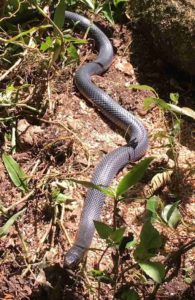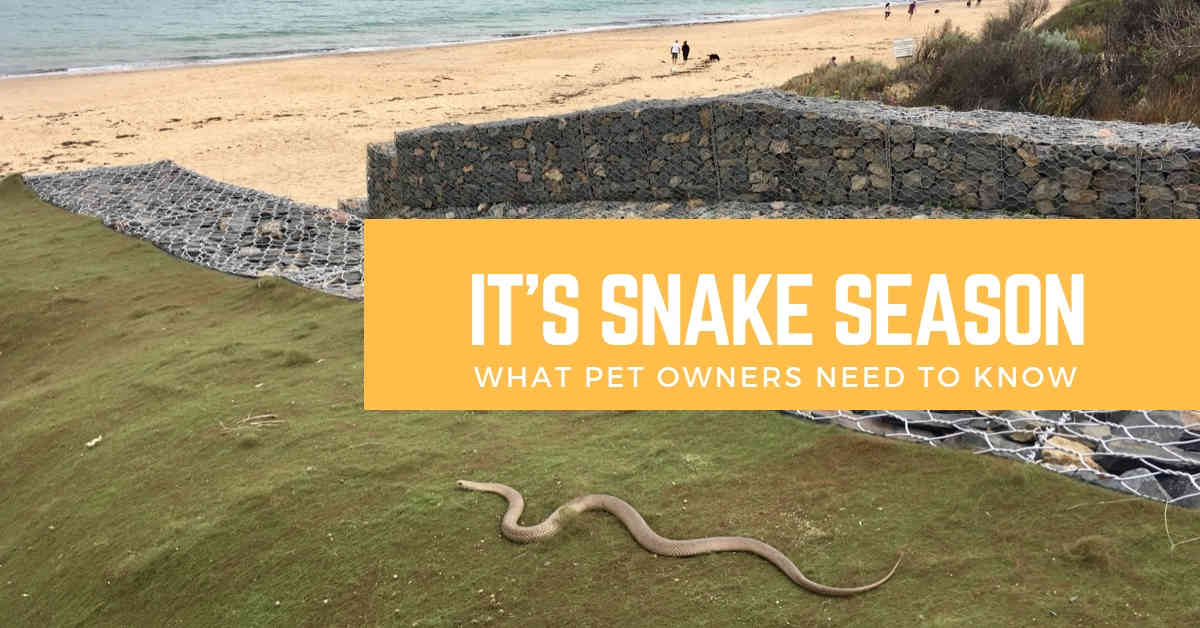Updated November 28, 2020
‘Emergency Care’ (details below)
If A Dog Or Cat Is Bitten By A Snake
- Stay calm and keep your pet still and quiet
- Do not try to catch or kill the snake
- Do not wait until symptoms develop
- Immediately travel to an emergency vet, calling on the way if possible
Now dive deeper…
All Australian pet owners need to be snake-aware, even city-dwellers. I lost a beautiful dog to a snake, and I don’t want it to happen to you.
Here’s what you need to know to prevent and treat snake bite in dogs and cats.
Which Snakes Are Dangerous?
There are three groups of Aussie snakes that cause most bites:
- Brown snakes
- Black snakes, including the King Brown
- Tiger snakes
In any region in Australia, there is usually only one snake that causes most of the problems. For us in southern Australia, that will be the Eastern Brown Snake. It’s not especially aggressive but will bite if cornered or attacked. I took the video quite safely as one crossed my path, but then I didn’t have a pet with me.
We also have the Red-bellied Black (below) found mostly near water, and Tiger Snakes in coastal areas.
Prevention of Snake Bite in Pets

Snakes will leave us alone if we leave them alone. Most like the quiet life as much as we do. They aren’t likely to bite your pets unless they have no other choice.
- Take special care during snake season. In southern Australia, that’s generally from October to April, depending on warm conditions. During this time it’s best to keep your dogs on leash a lot more.
- Keep your yard clear of cover for snakes by mowing, pruning, weeding, clearing up woodpiles and removing rubbish. Good excuse for a bonfire I reckon.
- Keep rats and mice under control. Snakes come into our yards after prey, so eliminate food sources for rodents and clear out their nests. Read here about rat poison and dogs.
- Keep cats inside. Cats will actively seek out snakes (I’ve even had one brought through the cat flap!), so anywhere near open land is too dangerous to let them out. In Adelaide, that’s along the rivers, adjacent to parklands and on the urban fringe. Indoor cats can be happy too!
- Choose off-leash areas carefully. They should be busy (to scare snakes away) and well-maintained. Look out for warning signs and avoid long grass or shrubby areas. All of our favourite Adelaide dog walks are too dangerous off-lead.
- Be careful when visiting unknown areas. I lost my Ruby dog when I left her in the yard of a holiday home. I’ll never forgive myself for not asking the question: “could there be snakes here?”
- Train dogs to leave snakes alone. I’ll admit I have no experience of this but there is no shortage of dog trainers offering the service. I still wouldn’t rely on it though.
The same goes for whether certain dog breeds are more likely to ignore snakes. Although it is probably true, I think all show enough interest to be in danger.
Signs of Snake Bite
Three types of snake venom cause different signs, depending on the snake species.
- A neurotoxin causes paralysis (most snakes)
- A myotoxin causes muscle damage (many snakes but not our Brown)
- An anticoagulant causes bleeding (less important)

What does a snake bite look like? Signs are highly variable and include some of the following:
- No wound! You usually can’t see a snake bite
- An unsteady, wobbly gait leading to hind leg weakness
- Unusual behaviours such as trembling or shaking
- Fast or shallow breathing
- Paralysis and dilated pupils (the picture shows a cat receiving antivenom in our hospital)
- Sometimes blood in the urine or bleeding (we don’t see this with brown snakes)
The links list other causes. There are important differences between cats and dogs:
- Dogs often collapse or vomit straight after being bitten and then appear to recover. This is a sure sign they received a fatal dose. Symptoms often appear within an hour and progress rapidly.
- Cats develop symptoms much more slowly than dogs, and often just get floppier and floppier. I once saw a cat come inside, go to sleep and only later fall off the lounge trying to get up.
Treatment Of Snakebite
Time is critical. If you see your pet near a snake, you must assume they’ve been bitten. My Ruby died in the car on the way to the local vet because we didn’t know she’d been bitten until the symptoms started.
I advise owners to come down so we can place a drip and give the necessary premedicants. Then we can start antivenom treatment instantly if we need to, like is happening for this cat who was brought to us paralysed.
Why don’t we give antivenom unless we’re sure?
- Antivenom is made from horse serum and can cause an anaphylactic reaction
- Antivenom is expensive so we try not to waste it
- No pet should die if antivenom is given early enough
Vets usually choose which antivenom to use based on local knowledge. For example, in my region, we only see Brown snake bites. However, in some areas, vets may need to do a test first or give a combined antivenin.
Other treatments may include intravenous fluids and respiratory support. It may take one to two weeks before a pet is fully recovered from snake bite but they can usually be sent home from hospital after one to two days.
Home Remedies Such As Vitamin C
Vitamin C is a popular home remedy for snake bite that was first used in North America. Its mode of action is thought to be by combating oxidative stress.
Even if it works for cytotoxic venoms of rattlesnakes or vipers (for which there is no evidence), Vitamin C has no place in the treatment of Australian snake bite. Most Australian snakes kill by the use of neurotoxins that cause paralysis. There is no conceivable way Vitamin C could interfere with such venom.
Any report of how a home snake bite remedy saved a dog or cat needs to be treated with scepticism. These were likely to be ‘dry’ bites that delivered little to no venom or from non-venomous snakes.
First Aid For Snake Bite
There’s no home treatment for snake bite but here’s what you can do on the way to the vet:
- Keep your pet quiet and still to slow down toxin absorption
- If a leg was bitten you can wrap it tightly, however, don’t waste time unless you’re sure
- Call the vet so they can get everything ready before you arrive
Most importantly, stay calm: it should be OK.
Have something to add? Comments (if open) will appear within 24 hours.
By Andrew Spanner BVSc(Hons) MVetStud, a vet in Adelaide, Australia. Meet his team here. The information provided here is not intended to be used as a substitute for going to the vet. If your pet is unwell, please seek veterinary attention.


How long after a king brown snake bite can complications occur in a 1 year old kelpie that got the antivenem within 2 hours of the bite
Hi Nat. King Browns don’t occur in my part of South Australia, so you might need to ask a vet more familiar with their specific venom.
My dog was bitten by presumably a black snake 5 days ago. He received the antivenom a few hours after the bite (the vet had no stock and had to find some) He has not eaten or been able to drink anything since. Both his liver and kidneys show signs of damage. How likely is he to recover fully do you think? He’s a 5 year old medium size bitzer. He has been on IV fluids for most of that time now.
Hi Karen. I’m sorry to hear about that. Only your vets will have access to enough information to be able to answer that question. Good luck.
Hey I’m pretty sure my cat has been bitten by a snake and this happened yesterday morning. Its appearance Has changed and fast. As far as symptoms, it’s been slow but I could instantly tell she has been bitten but wasn’t quite sure until I sent photos to her vet. He advised for now until the am to just give her 1/4 children’s Benadryl and then to bring her in immediately so he could administer her some dextron and antibiotics which he advised was an absolute must. Prayers please and just know she’s a tough kitty.
Hi Mississippi. The information on this page only applies to snakes in Australia.
I recently had got a cat and a few days went by and the cat was fine until he went outside and when he came back he came back stiff and paralyzed but he is alive and his stool is fine. We went to the vet and they couldn’t diagnose anything but gave us anti-Biotics. If any know what’s wrong I will provide pictures. Thank you
Hi Laura lie. Sudden onset of loss of function in the back legs in a young cat could be snakebite, trauma but also possibly specific venomous animals in your area. I’m afraid a photo won’t help and your vets are probably going to know the best. Good luck.
Thank you for this.
How much time do you have to get pet to vetl
Hi India. The time is highly variable depending on the number of bites, type of snake, species bitten (dogs less time than cats) and location of bites (head is worse). My own dog died within 30 minutes of the onset of symptoms as she was a small terrier who probably sustained many bites to the head. It’s usually more like 1 to 2 hours, but that’s why I advise always acting as if your pet has been bitten even if you’re not sure. If the symptoms start at the vet there’s nearly always enough time to save them.
How soon after a pet is bitten would the onset symptoms begin?
It depends on how many bites, where they are bitten and the amount of venom injected. It could be anything from 10 minutes to several hours, but typically 30 to 60 minutes.
Thank you so much for explaining what happens and what to do regarding snake bites. That was so informative. I have not read anything before that explained it so well.
Thank you so much. It certainly is snake season and you have given great advice. I am very aware when I walk my dog.